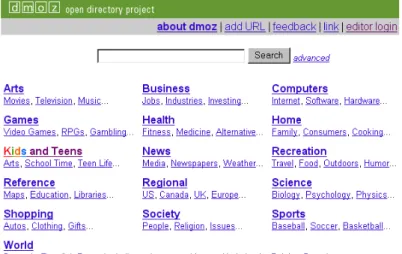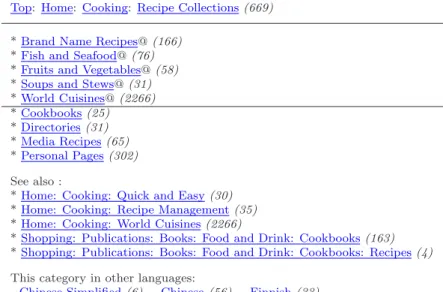Symlinks as boundary objects
Lejeune Christophe
June 2006
Tech-CICO lab. (CNRS FRE 2848)Charles Delaunay Institute
University of Technology in Troyes 12, Rue Marie Curie – BP2060 10000 Troyes (France)
This talk1 is concerned with the «lived work» of a web directory’s builders
[5]. On the Internet, web directories provide lists of addresses of websites grouped by themes. These hierarchically organised directories are presented as an alternative to conventional search engines [4]. They are shaped as trees, with general topics at the top and specialised nodes underneath. Each node covers a thematic field and may comprise either sub-categories or references to external websites (though technically possible empty nodes are deprecated). The name of these tools (directories) refer to the history of file system components.
This paper focuses on a team involved in building such a directory in the spirit of free content projects2. Started in 1998 under the name GnuHoo [12],
this volunteer-based project aimed to propose an alternate to the leading in-dustry directories. Adopting the Debian social contract, this social organisation aimed to be more efficient than a team of hired employees [6]. One can not say whether the purpose is successfully reached. The project was anyway acknowl-edged by the industry : Netscape proposed to support the project six months (only) after it was launch and Google adopts it as his own directory before it was two years old. This historical background of the project shows how Rich Skrenta and Bob Truel (its founders) claim to be part of the free software movement [13, 14, 17, 10].
The organisation of the community assumes a social division of labour: each person is responsible for one (or more) category. For this work to be coordinated, members extensively use discussion forums [8, 3, 2]. In the very practical and situated details of their everyday work, members of the community organise the hierarchical database (so the user can easily glance through the database). For this work to be achieved, given the strong constraint of the tree shape, they design horizontal relations across the whole directory. These links are of three kinds: related categories, alternate language and symbolic links.
1This is an extended abstract of the conference given in the workshop on Ethnography of
Code in Lancaster, UK, on March 31th, 2006.
2The Open Directory Project (http://www.dmoz.org/) is a peer community supported by Netscape.
TeamEthno-online Issue 2, June 2006, 108-111
Figure 1: The Open Directory Project homepage
Related categories are links to rubric(s) that could interest the user (sister categories). The full path and name of the target category are featured. The heading of the related categories set is «see also». This device is indeed a reference to the logic of the librarian work practice [1, 7, 9].
Alternate language appears late in 2000 as a consequence of the interna-tionalisation of the Open Directory Project. With more and more members everyday, the need for categories in other languages than English became a big issue. Alternate directories were then created under a (new) category at the top level. Named «world», this proxy comprises all the non-English branches. In the very beginning, the relations between English categories and non-English categories were made with related categories. Then, the alternate language links were introduced for this dedicated purpose. On the directory interface, these links are featured under the related categories field. The name of the target node is replaced by its language. Only one equivalent for each language is permitted. Symbolic links are of a particular semantics : these relations indicate a category that can be considered as sub-rubrics (child categories). The target category of a symbolic link may or may not belong to the same branch. If it is included in the same branch (ie, if the source category belongs to the path of the target category) the symbolic link is then just a vertical shortcut (this seems to be the reason why this device was introduced [16]). If the source and target nodes belong to different branches, then the symbolic link is a sideways bridge that indicates (as related categories) that another rubric may be of interest and (contrary to related categories) that the target category could be considered as a part, or a child, of the source category. Symbolic links are listed among other sub-categories; they are signalled by a trailing «@» (see «Fruits and Vegetables»
TeamEthno-online Issue 2, June 2006, 108-111
Top:Home:Cooking:Recipe Collections(669)
*Brand Name Recipes@ (166) *Fish and Seafood@ (76) *Fruits and Vegetables@ (58) *Soups and Stews@ (31) *World Cuisines@ (2266) *Cookbooks(25) *Directories(31) *Media Recipes(65) *Personal Pages(302) See also :
*Home: Cooking: Quick and Easy(30)
*Home: Cooking: Recipe Management(35)
*Home: Cooking: World Cuisines(2266)
*Shopping: Publications: Books: Food and Drink: Cookbooks(163)
*Shopping: Publications: Books: Food and Drink: Cookbooks: Recipes(4)
This category in other languages:
Chinese Simplified(6) Chinese(56) Finnish(33)
Figure 2: Extract from the page of a category
on the illustrated example, figure 2). Neither the name nor the path of the target node are featured; instead, another name is included (by the person responsible for the category).
ln -s /target/folder /path/to/link creation ls -l /path/to/ list of a folder content lrwxrwxrwx user group file one common file and -rw-r--r-- user group link -> /target/folder ...a symbolic link
Figure 3: Creating and exhibiting a symbolic link under Debian Linux
The «symlink» name is borrowed from the constituent function of the Unix [11, 15] Operating System (widely spread since the advent of the free operating system GNU/Linux). These links to folder are dedicated to user convenience and maintenance of the system (such as compilation of new software/kernel). The way they are created and listed is illustred in figure 3. As a conclusion, we could state that the Open Directory community refer to three core business that contribute to define its social identity : search engines, library and free software.
Keywords Knowledge Management, Information System, CSCW, Ethnomethod-ology, Free Software, Directory, File System, Lebenswelt, Respecification.
References
[1] Aitchison, J., Gilchrist, A., and Bawden, D. Thesaurus
Construc-tion and Use: A Practical Manual. Fitzroy Dearborn, Chicago, 2000.
TeamEthno-online Issue 2, June 2006, 108-111
[2] Auray, N. La r´egulation de la connaissance : arbitrage sur la taille et ges-tion aux fronti`eres dans la communaut´e Debian. Revue d’´economie politique
113 (2003), 161–182.
[3] Auray, N. Le sens du juste dans un noyau d’experts. Debian et le pu-ritanisme civique. In Conventions et Institutions : approfondissements
th´eoriques et contributions au d´ebat politique (2003).
[4] Beauvisage, T., and Assadi, H. Les annuaires du web. Entre interm´e-diation neutre et choix ´editorial marqu´e. R´eseaux 20, 116 (2002), 141–170.
[5] Button, G. The mundane work of writing and reading computer pro-grams. In Situated order: Studies in the social organization of talk and
embodied action, P. Ten Have and G. Psathas, Eds. International Institute
for Ethnomethodology and Conversation Analysis & University Press of America, Washington, 1995, pp. 231–258.
[6] Chand, D., and David, G. What global software development can learn from open source phenomenon? 2005.
[7] Gilchrist, A. Thesauri, taxonomies and ontologies - an etymological note.
Journal of Documentation 59, 1 (2003), 7–18.
[8] Lejeune, C. Indexation et organisation de la connaissance. La r´egulation des d´ecisions sur un forum de discussion. Les cahiers du num´erique 3, n◦ 2 (2002), 129–144.
[9] Lejeune, C. D’un annuaire de sites internet `a l’organisation documentaire. Une sociologie des relations s´emantiques. Association Belge de
Documen-tation (2006).
[10] Lessig, L. Free Culture. How big media uses technology and the law to lock
down culture and control creativity. The Penguin Press, New York, 2004.
[11] McKusick, M. Twenty years of Berkeley Unix. From AT&T-owned to freely redistributable. In Open Sources: Voices from the Revolution, C. Di Bona, S. Ockman, and M. Stone, Eds. O’Reilly, 1999.
[12] Skrenta, R. Genesis of the Open Directory Project. The Internet
Devel-oper Group (2001).
[13] Stallman, R. M. Free Unix ! In Libres enfants du savoir num´erique.
Une anthologie du ”libre”, O. Blondeau and F. Latrive, Eds. ´Eclat, Paris, 1983, pp. 337–340.
[14] Stallman, R. M. Free Software, Free Society: selected essays of Richard
M. Stallman. Free Software Foundation, Boston, 2002.
[15] Tanenbaum, A. S. Modern Operating Systems. Prentice Hall, Upper Saddle River, 2001.
[16] Thomas, A., and Shearer, J., Eds. Internet Searching and Indexing.
The Subject Approach. The Haworth Press, New York, 2000.
[17] Williams, S. Free as in Freedom. Richard Stallman’s Crusade for Free
Software. O’Reilly, Sebastopol, 2002.

